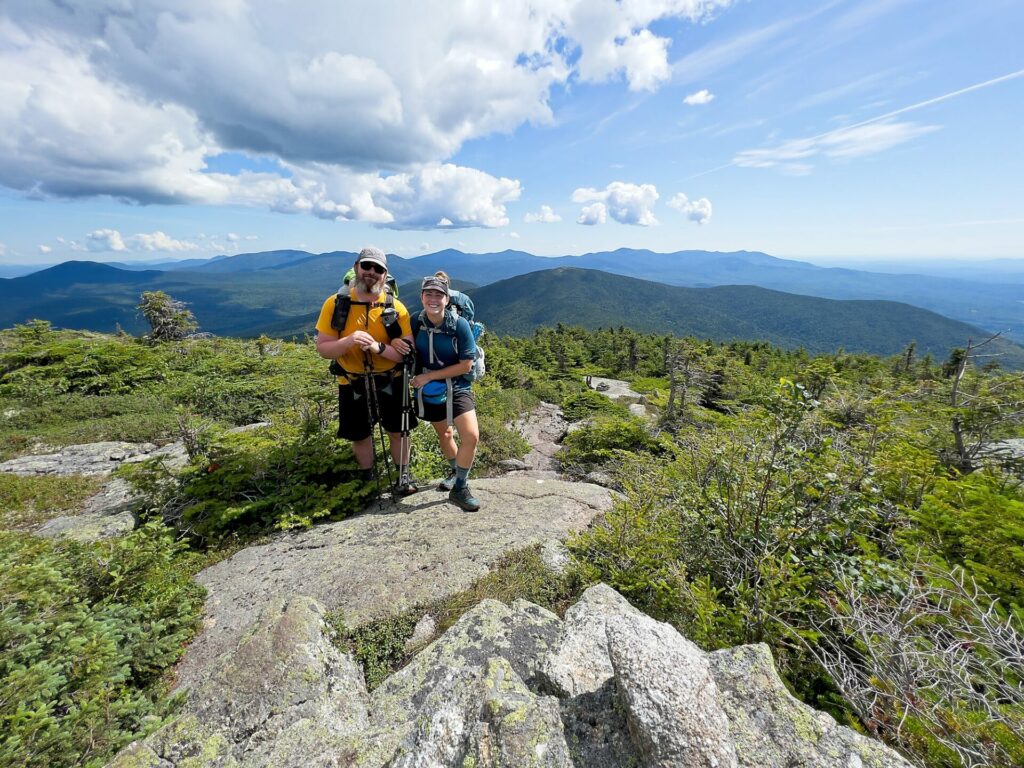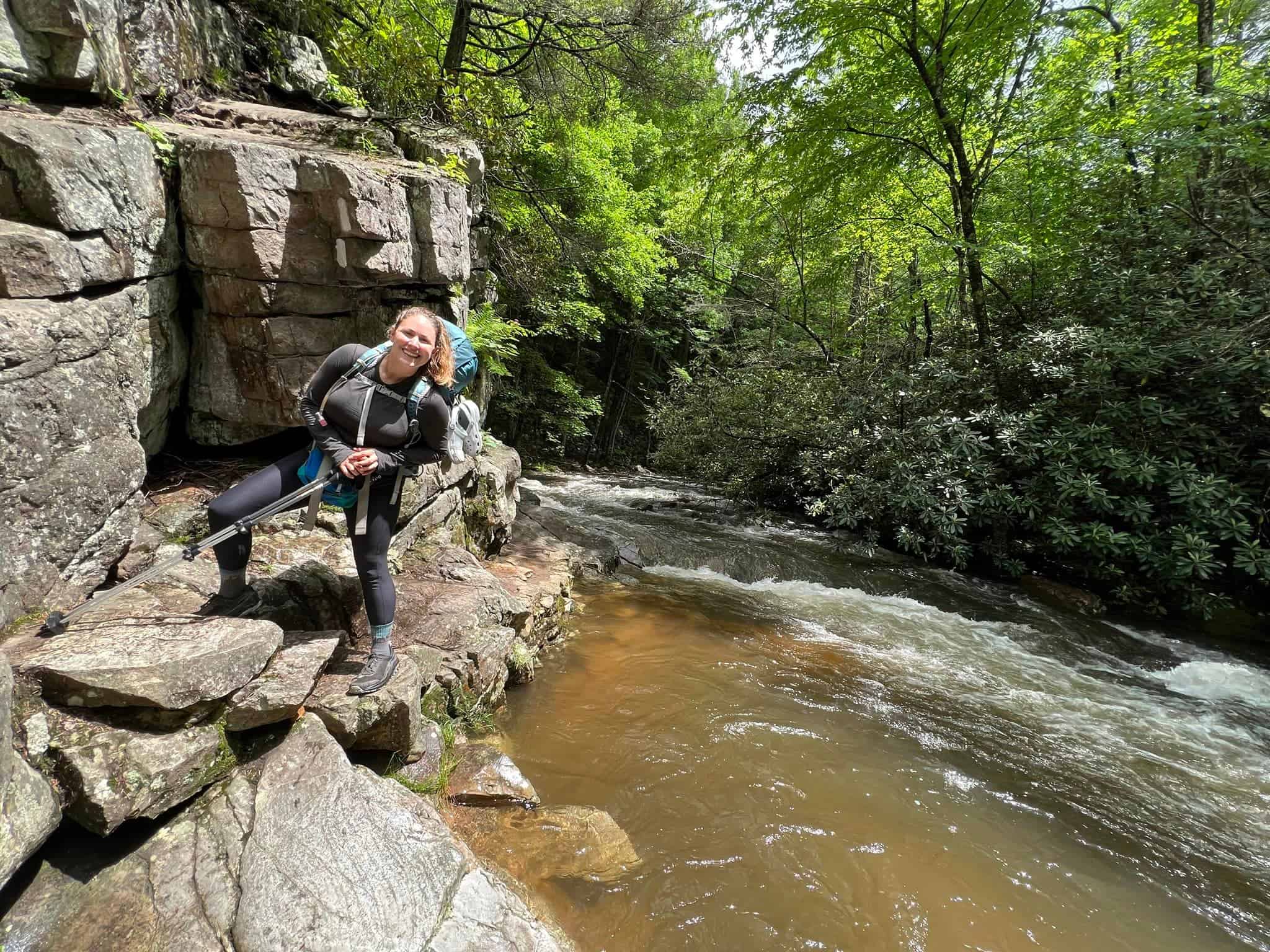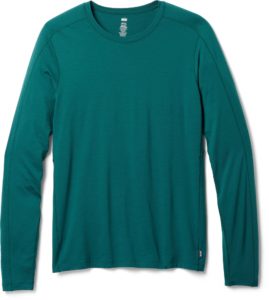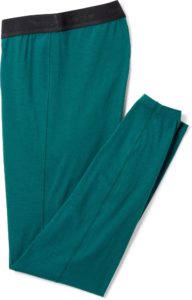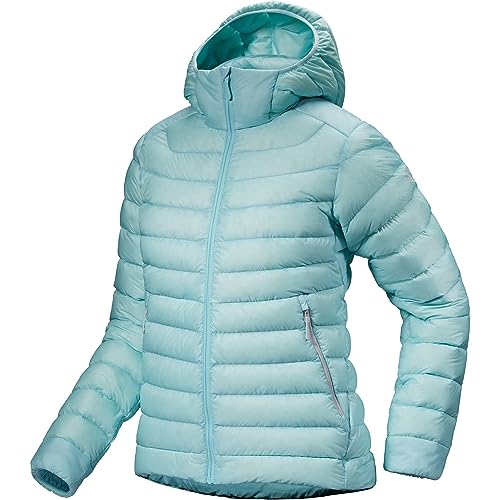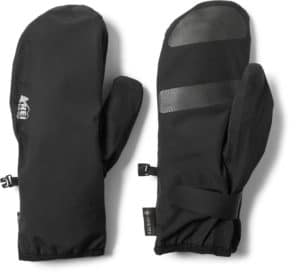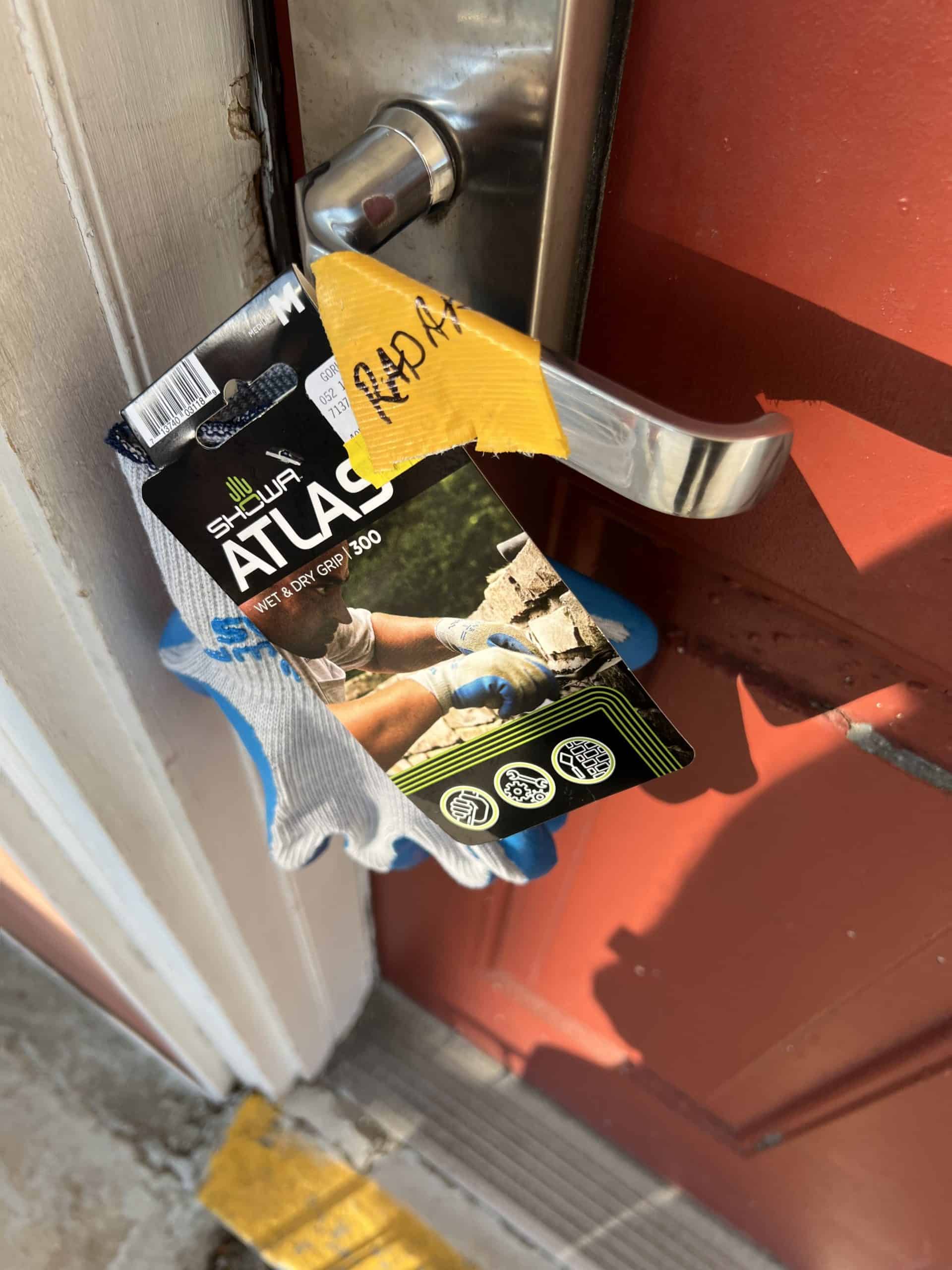Last updated on March 31st, 2025 at 03:23 pm

NOTE: This post is part of a comprehensive Appalachian Trail thru-hike gear guide.
If you have arrived here but would like to see all the other categories, start here.
Multiple categories are worth considering when deciding what backpacking clothes to bring on the Appalachian Trail. I will review each attire category and discuss why each piece is worth space in your pack.
Clothing
For us, clothing was very much a learn-as-you-go category.
What will work for you on trail will likely differ from what has worked for you in everyday life or athletic activities.
Depending on how you’ve shopped in the past, the functions you are looking for from these clothing items may be ones you have never overly paid attention to before. (This is because many of us have been trained over the years to search for style over function.)
That mindset will not serve you in this category. On a thru-hike, function is king.
Tip: You will only want to carry some articles of clothing for some seasons throughout this hike. If you have the option, try to prearrange a “postmaster” friend or family member who can ship pieces back and forth to you as the seasons change and as you learn more about yourself. Ours was my mom, and it was highly beneficial to have her assistance.
There are tons of outdoor brands with clothing available in the following categories. I will mention what worked for us and how it fits the bill for each category.
The best thing you can do when searching is evaluate the materials and functionality of each item to see if it will work for you on the trail.
Hiking Clothes: Top and Bottom
Your hiking top and bottom are the core pieces you choose to hike in every day.
What you’ll want to hike in will vary depending on trail conditions and the season, so consider what time of year you’ll be hiking.
That said, the goal is to have versatile pieces that can cover as many conditions and seasons as possible.
Since the Appalachian Trail sees a lot of rain, the best hiking clothing for this particular trail is made from either wool or synthetic fabrics since those materials retain warmth when wet.
Hiking Top
When searching for a hiking top, you’re looking for a shirt that wicks away moisture and odor, dries fast, and weighs as little as possible.
I went through a handful of shirts along the trail. These were my favorites:
My Picks:
Women’s Smartwool Merino Sport 150 Hoodie: Amazon | REI
(5.9 oz)
- Odor-resistant
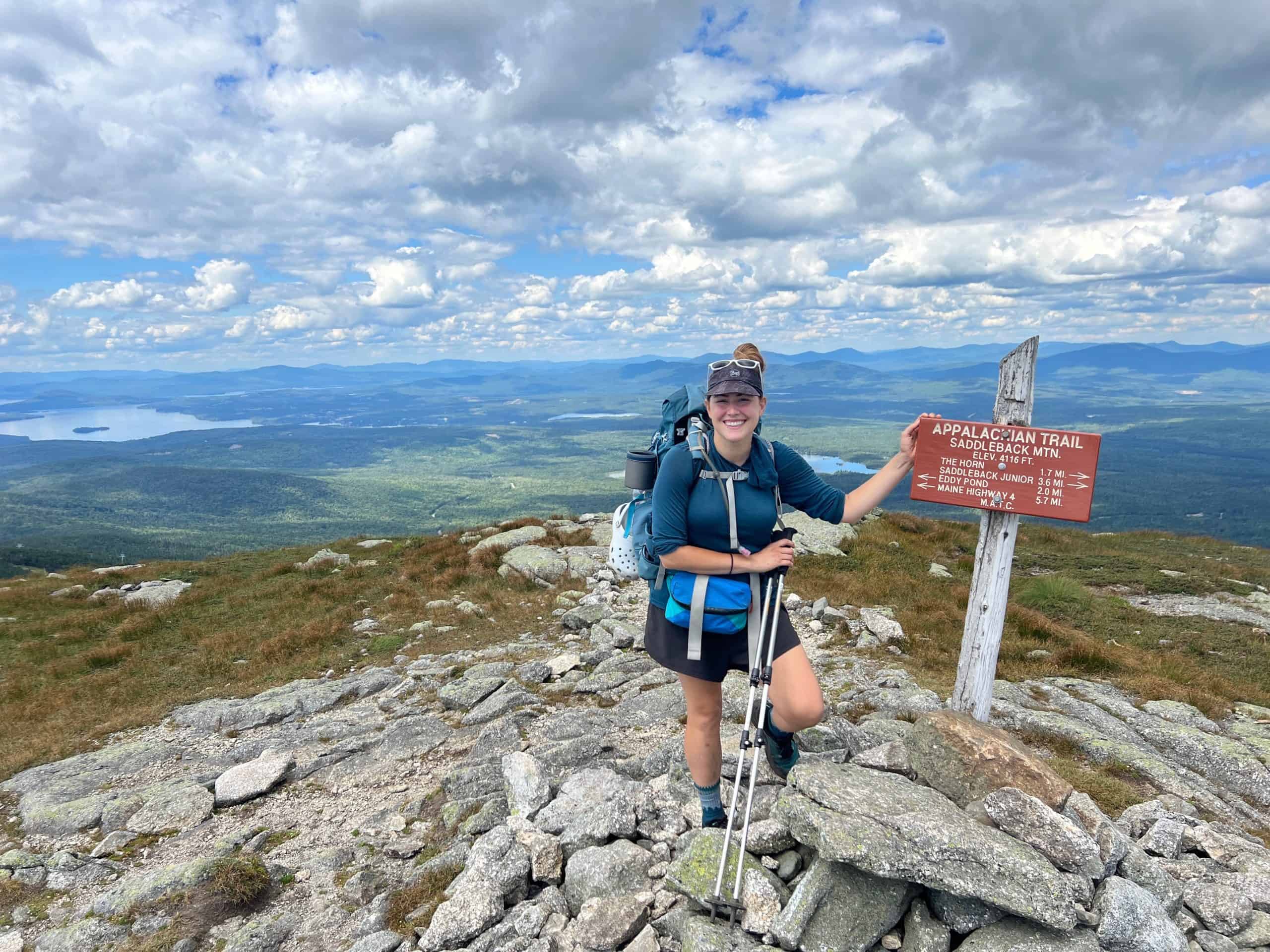
During the first week of our thru-hike, we reached the Mountain Crossings trail store and knew we needed better hiking tops.
We both got one of these Smartwool hoodies and wore the hell out of them along the entire trail.
This shirt had every feature mentioned above that’s important to find in a hiking top, plus UPF 20+ protection.
One minor con in the durability of this shirt: My pack kept chewing the armpits out of it.
Smartwool has a fantastic guarantee on their products, though, and anytime one ripped, they were quick to help me get a replacement.
Outdoor Research Women’s Echo T-Shirt: Amazon
- SUN PROTECTION CLOTHING FOR WOMEN: Featuring eco-friendly mesh fabric with a stretch fit, this Outdoor Research T-shirt helps keep you cool and dry in hot weather. Its ultralight construction offers you enhanced comfort, movement, and fit.
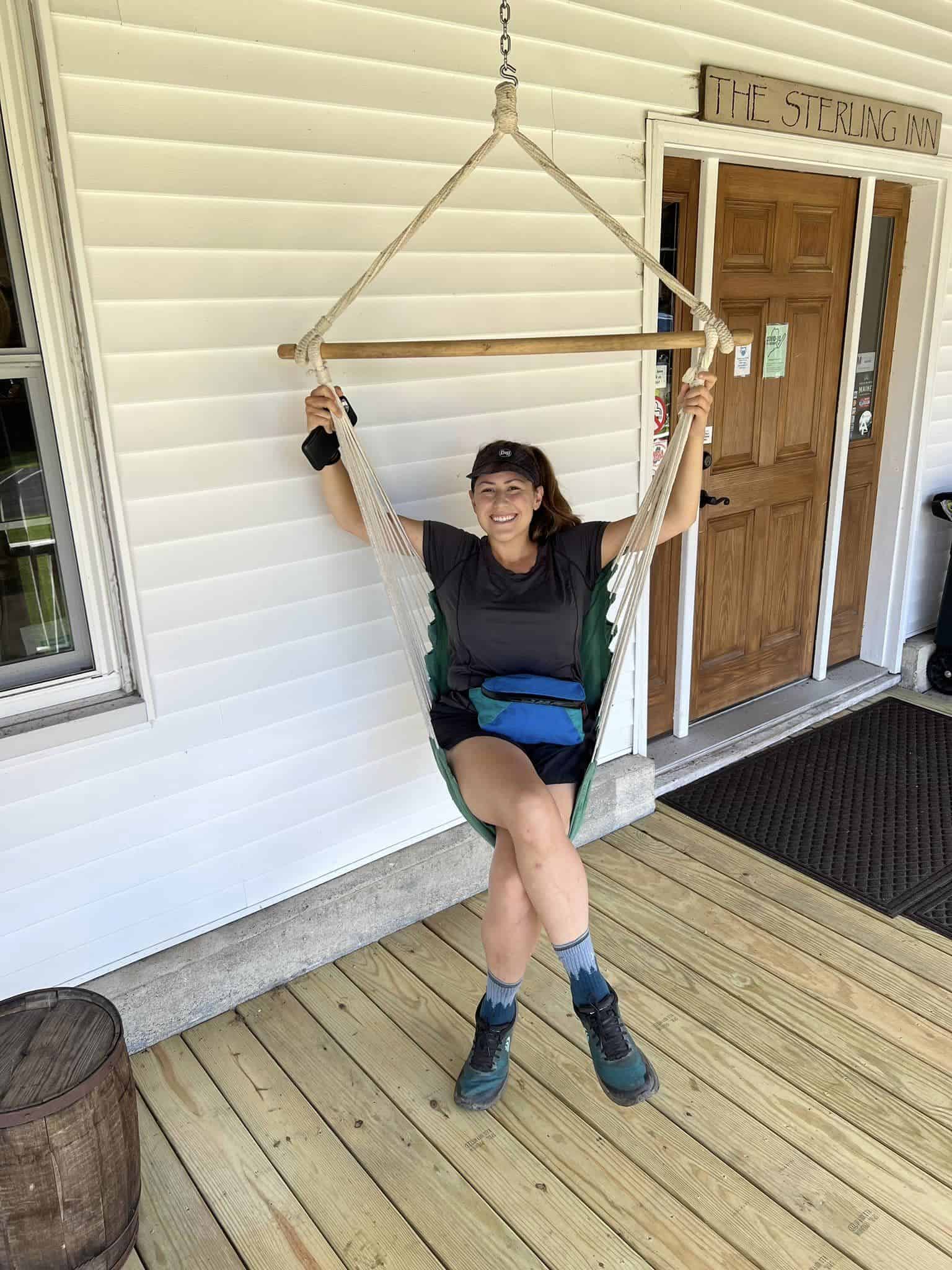
Husband’s Picks:
Men’s Smartwool Merino Sport 150 Hoodie: Amazon | REI | Backcountry
As mentioned above, we both bought these Smartwool hoodies at Mountain Crossings.
Barrett runs very warm. So when it was cold outside, he opted to wear this Smartwool hoodie along with the next shirt from Outdoor Research, the Echo T-shirt, over the top of it, instead of a fleece mid-layer.
He discovered he also loved sleeping in this shirt at a certain point and got a second one to sleep in.
Outdoor Research Men’s Echo T-Shirt: Amazon
- Fabric Performance: Active Fresh odor control, AirVentmoisture management, UPF 15 Sun protection
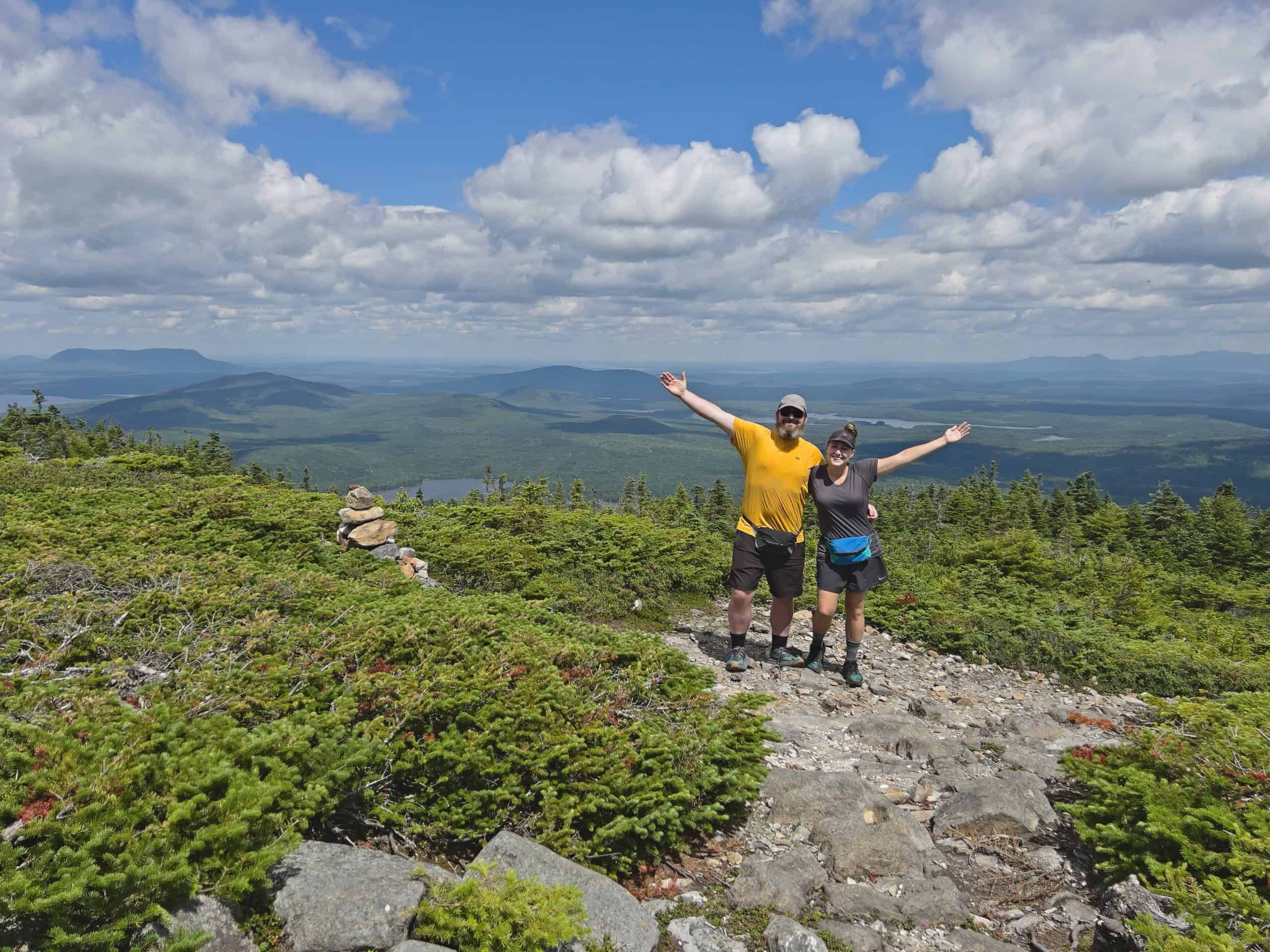
Hiking Bottom
What goes for hiking tops also applies to bottoms. Anything that can wick away moisture and odor, dry fast, and is lightweight, wins.
My Pick:
From a woman’s perspective, I found that:
• If it was warm outside, I wore shorts.
• If it was warm and raining, I wore shorts.
• If it was cold and raining, I wore shorts (leggings if it was extra cold) and rain pants.
• If it was cold, I wore leggings.
(I’ve never been a huge fan of hiking dresses, but I also saw those on the trail!)
Leggings
Thicker leggings are great for colder days.
Thinner leggings are great for warmer days when you don’t want to wear shorts because you still want protection from the elements along the trail.
Before departure, I weighed all my leggings. I found the 3-4 that weighed the least and took them out on test hikes.
Some of my heavier leggings kept me too warm, even in cold conditions.
I ended up taking the two lightest pairs I owned.
They also are the two pairs of leggings I’ve hiked in most over the past five years across America. (The AT finally killed them both.)
So instead of giving you shopping links for these, I will explain why they rock and what you should look for when picking out current leggings.
Athleta Black High Rise Metro Drifter Leggings
(The cold weather pair – 9.3 oz – 88% Nylon / 12% Spandex)
Under Armor Leggings
(The warm weather pair – 6.7 oz – ~ 70% Polyester / 30% Elastane)
One of these leggings is mostly nylon, while the other is mostly polyester. Here’s what you should know about those two synthetics:
Both nylon and polyester are widespread in activewear because they wick moisture and dry quickly.
Nylon is stronger, more durable, and scratch-resistant than polyester.
Nylon traps heat and will keep your legs warm. So they may only be a good fit for some people. I would not recommend nylon leggings for a warm day, but my always-cold legs found them perfect for frigid hiking days.
Polyester options will be lightweight and dry quicker.
Shorts
Nylon and polyester are the two most common materials you’ll find in active shorts as well.
Try some pairs and see what you like the best.
For ladies, the shorts with the most trail hype are the Patagonia Barely Baggies, so make sure to give those a try. (The shorts with the most trail hype shorts for men are the Patagonia Nine Trails.)
For me, I LOVED these DSG Women’s Stride Shorts from Dick’s Sporting Goods (pictured below).
(5 oz – Polyester / Spandex)
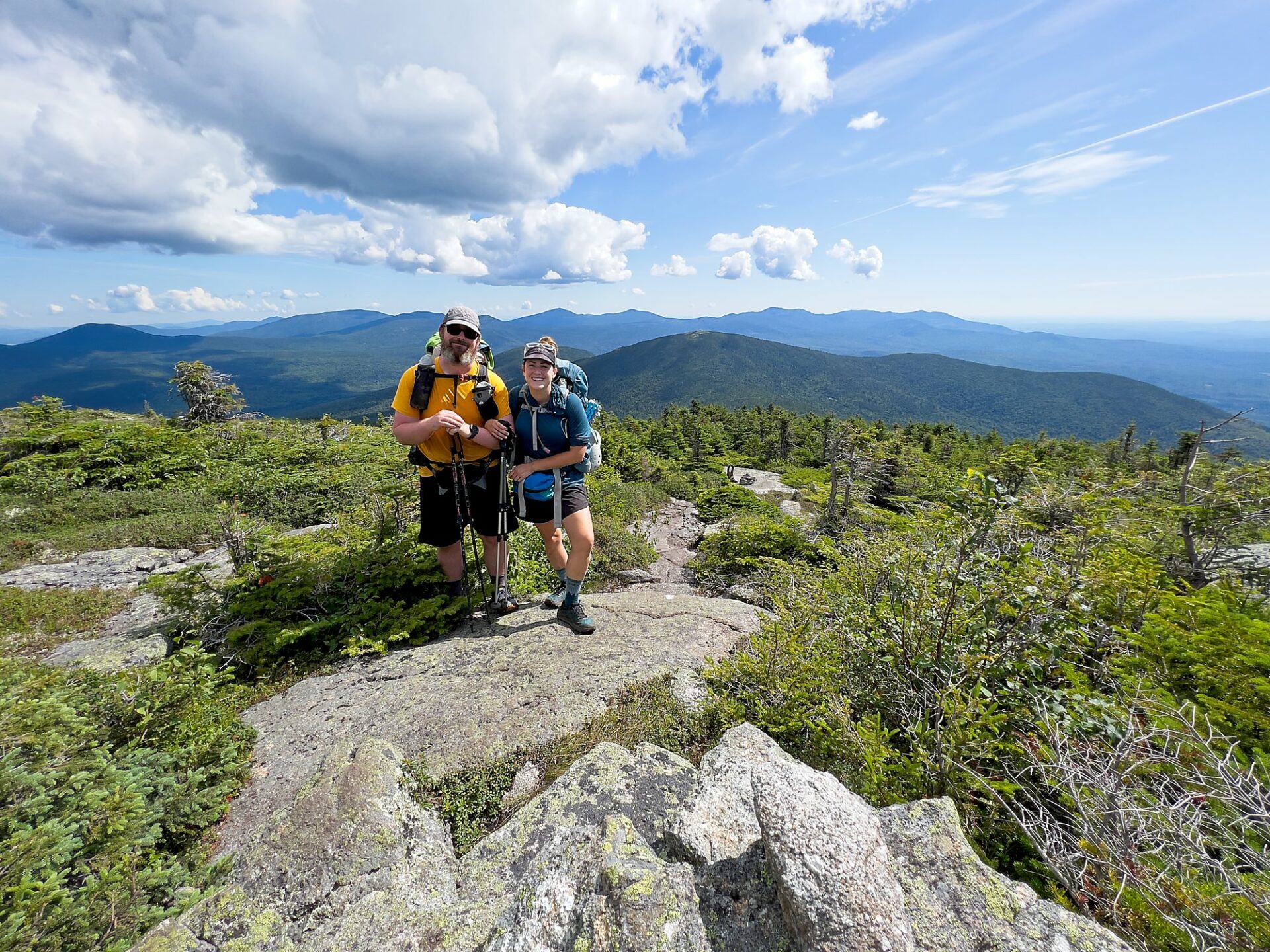
Their only flaw was the lack of a pocket. I recommend giving them a try.
My second favorite shorts were these Nike Women’s Tempo Luxe 5″ Running Shorts I found at a running store in a trail town. I couldn’t believe how lightweight they were. 3.5 ounces for shorts! Are you kidding me!?
(3.5 oz – Polyester)

They only sold the 5″ version, so that’s what I hiked in. However, if I had the choice, I probably would have opted for a 3″ version. They would have weighed slightly less and had less of that long basketball short feel.
(The 5″ version I had has been discontinued. The item below is the updated version. I’m not sure how much the new version weighs.)
- Nike Dry fabric helps you stay dry and comfortable
They were my backup shorts. I almost always wore the DSG shorts, but if they got too gross due to rain or sweat, I had these shorts as a backup. Or if it was sweltering in the evening, I also had them to sleep in.
Barrett loved Dick’s Sporting Goods’ Agility Woven Shorts for the trail. They were light, dried quickly, and had deep pockets. He also loved their lack of a sewn-in crotch.
Husband’s Pick:
Barrett loved Dick’s Sporting Goods’ Men’s 8” Agility Woven Shorts for the trail (pictured below). They were light, dried quickly, and had deep pockets. He also loved their lack of a sewn-in crotch.
(6.4 oz – Polyester / Spandex)
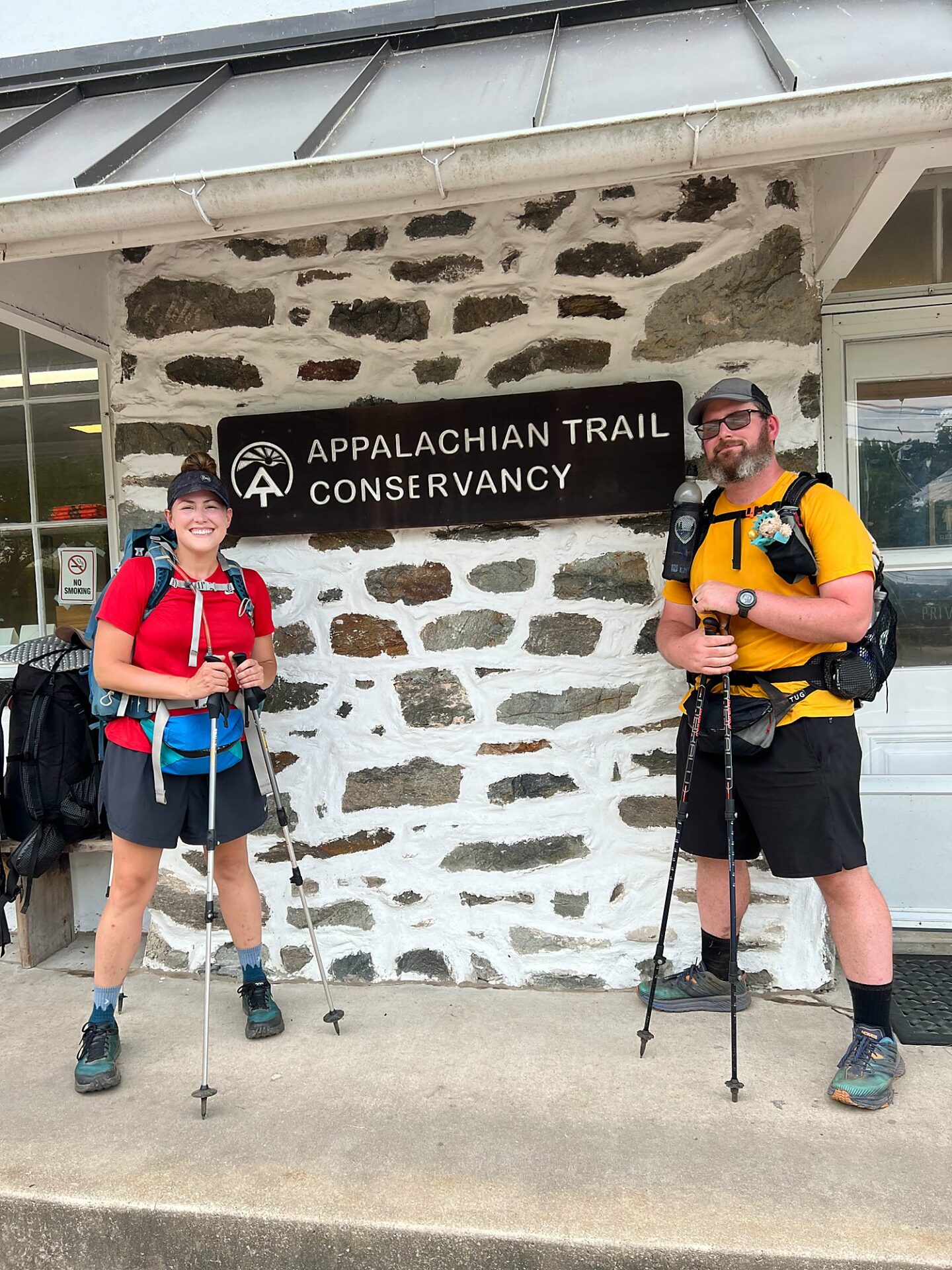
Base Layer
Base layers provide a lightweight layer of warmth for the evenings and colder seasons on trail.
They help you stay warm while also wicking sweat away.
When shopping for base layers, you want a snug-fitting top and bottom made from moisture-wicking material, generally synthetic or wool.
Here’s a chart to help you pick between the two fabric types.
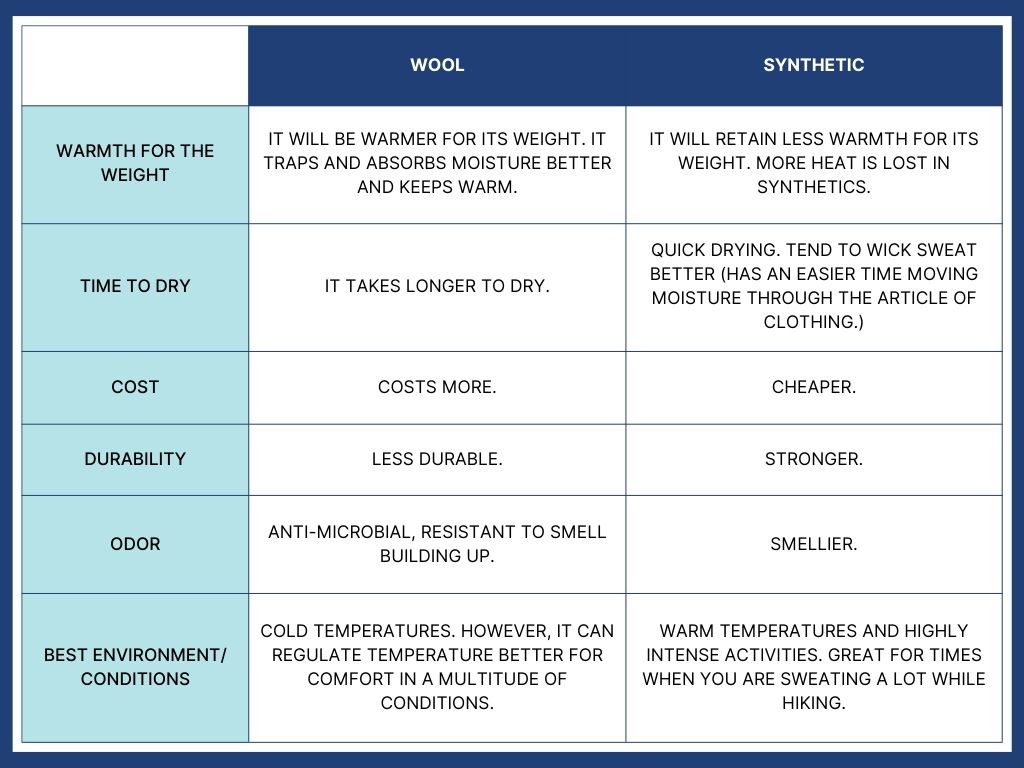
My Picks:
I started with two tops, a wool/synthetic hybrid and a synthetic, as well as a synthetic bottom.
(In the beginning, one top was for hiking, one for sleeping.)
I went with synthetic mainly for budget reasons.
I decided to save some money in this category since we weren’t hiking in the winter, so I didn’t need that positive feature of wool. I also know I don’t sweat as intensely as my husband and could get away with a synthetic option longer than he could.
Once it warmed up, I kept the lighter synthetic top for sleeping and shipped the heavier one home, never needing it again (in part due to the addition of my North Face fleece midlayer at the end of the hike. More on that in the following category.)
I slept in the 32 DEGREES base layer top almost every night, except during the hottest summer days.
I hiked in the base layers under my hiking outfit on cold days.
32 DEGREES Heat Womens Ultra Soft Thermal Lightweight Baselayer Scoop Neck Long Sleeve Top: Amazon
(4.1 oz, Polyester/Spandex)

Eddie Bauer Outlet Performance Baselayer Pants: Eddie Bauer Outlet
(5.4 oz – Polyester)
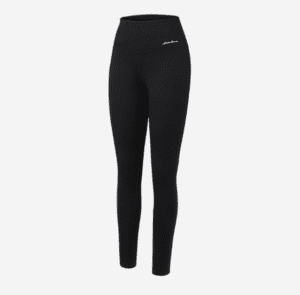
Midlayer
Having a midlayer gives you an added option for regulating your warmth.
They are great to add over a base layer in the cold or to wear on their own when hiking in that middle-temperature zone where you need a bit more warmth than your hiking shirt provides but want to avoid hiking in your puffy.
And on super cold evenings, they also provide a layer of warmth between your base layer and your puffy.
Fleece, wool, down, and synthetic options are available in this category.
Much like your base layer, what’s most important is that your midlayer is also breathable, quick-drying, and capable of moisture-wicking, so they can work together while hiking in the cold.
My Pick:
I started with the Outdoor Research Women’s Trail Mix Cowl Pullover (11.9 oz), but I found that midlayer too bulky, heavy for thru-hiking, and too similar in the warmth provided to my jacket. I sent it home.
After summer, I was reconnected with my synthetic Women’s Winter Warm Essential ¼-Zip from the North Face that I left packed up at home, and I enjoyed hiking in it a lot more.
I wore it a ton during the last two months of our hike. It was lightweight but still provided tons of warmth.
Women’s Winter Warm Essential ¼-Zip from the North Face: Amazon | REI
(8.3 oz)
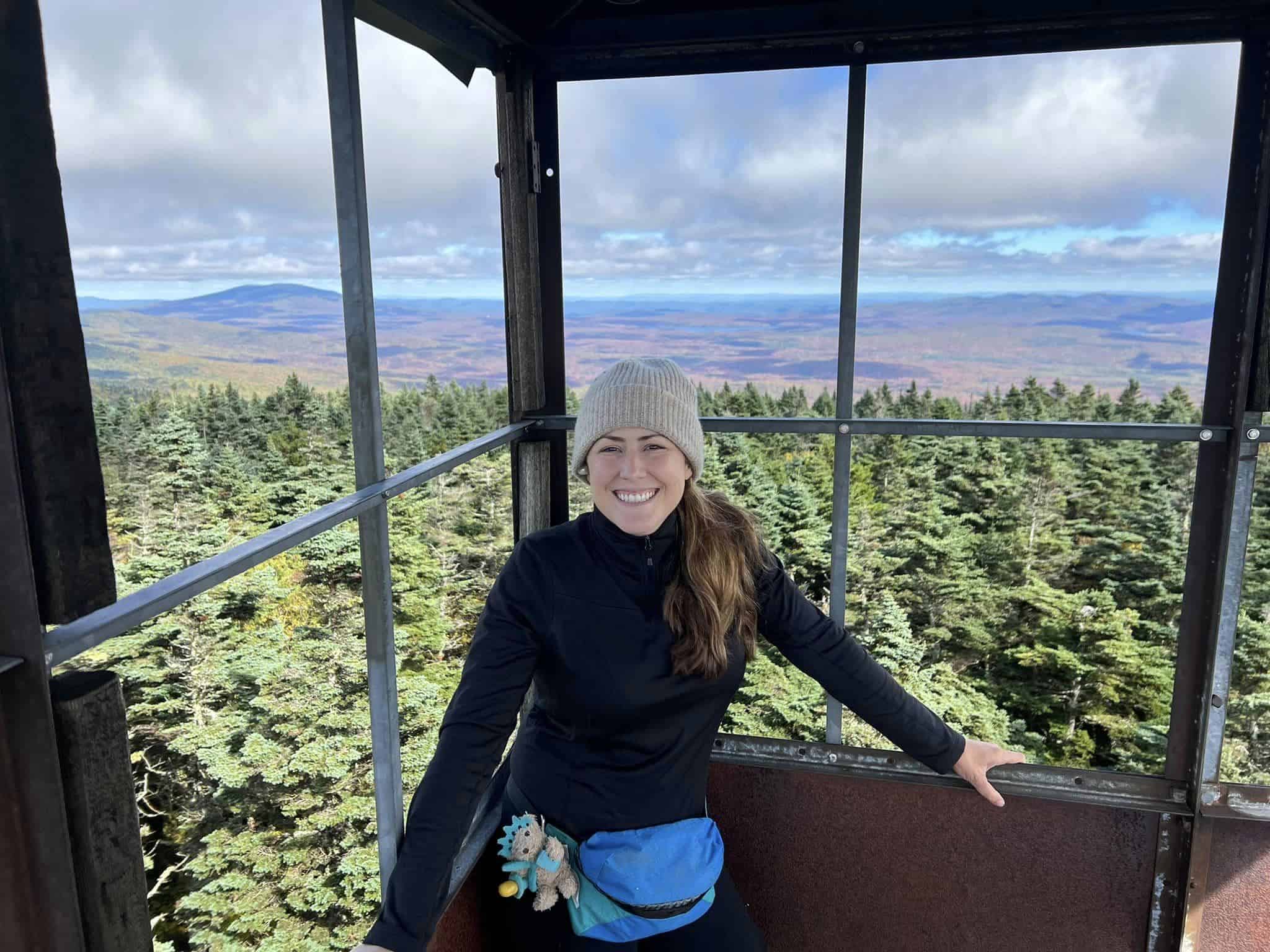
Husband’s Pick:
Barrett runs a lot warmer than I do. He did not feel the need for a fleece midlayer.
Insulating “Puffy” Jacket
An insulating jacket, also known as a “puffy,” is a three-season jacket that will give you a bit of water and wind resistance and keep your body warm during the many hours you’re not hiking.
This is an important piece. I wore mine more than I didn’t.
When deciding which one to purchase, you’ll want to consider the insulation materials, warmth-to-weight ratio, and durability.
Insulation Materials
Here is the same down vs. synthetic comparison chart previously seen in the sleeping bag and quilt section:
Synthetic vs. Down in a Nutshell
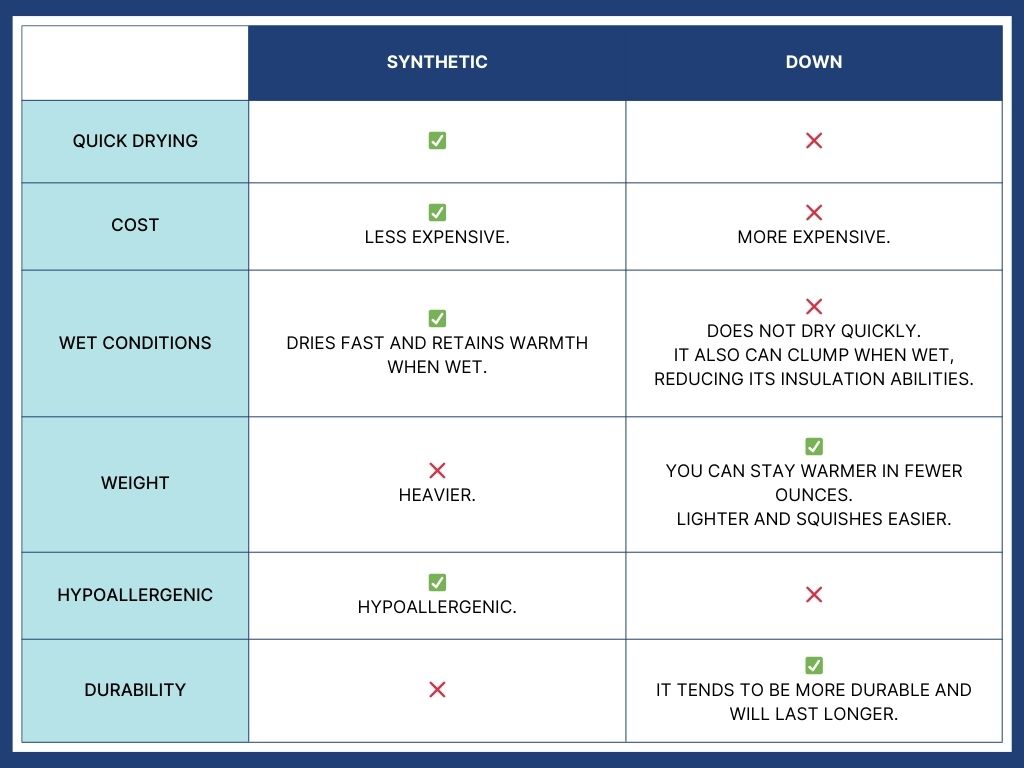
The choice between down and synthetic is yours to make, but remember that the AT is a notoriously wet trail, and synthetic will generally retain its loft and warmth better when wet and dry faster than down.
A jacket with a fill power of 750 or up is recommended if opting for down.
Also, insulating jackets do not have a warmth rating system like sleeping bags. Therefore, this is another item to try a few of and find what keeps you the warmest.
A snug fit is best for warmth, but with some room, if you want to layer underneath it.
Warmth-to-Weight Ratio
You want enough insulation to keep you warm but not be too heavy to carry in your pack.
Puffy weight is currently commonly around 13-14 oz.
Durability
You’ll want a jacket durable enough not to be easily ripped open on branches, picnic tables, etc.
My Pick:
Arc’teryx Atom Insulated Hoody (Previously the Atom LT Hoody): Amazon | REI
(now 11 oz, was 12 oz)
- HIGH PERFORMANCE DESIGN - Known for its water-resistance, insulated mid layers and high degree of weather resistance, this premium women’s lightweight hoodie is versatile and durable.
I won’t lie; I did not enjoy shopping for a puffy.
I tried many women’s puffies and found most of them relatively large and constricting.
That was ultimately the main reason I selected the Arc’teryx Atom Insulated Hoody, despite it not being the warmest option.
And although it’s not recommended to hike in your puffy (because it can lead to overheating, and if the puffy gets wet inside due to sweating, it becomes a less effective insulator), this jacket was honestly more of a midlayer and great to hike in on really cold days, yet still generally warm enough in the evenings, when layered with a baselayer and midlayer.
Ultimately, this lightweight insulated jacket is a great midlayer that’s breathable, wind resistant, moisture resistant and repelling, fast drying, cinchable, and down extremely small.
I’m happy to have it in my jacket kit.
However, if I did it all over again, I’d get my husband’s pick, the Enlightened Equipment Torrid.
The Enlightened Equipment Torrid does everything the Arc’teryx jacket does, with a superior warmth-to-weight ratio, while still being less constrictive than many other popular puffies.
Barrett loved how well it cinched up and trapped warm air inside.
There were a few frigid nights I was grateful my husband tends to run warm, and I could wear this jacket instead of mine. It’s fantastic.
On nights he was cold, I was frequently jealous of him.
This jacket is at the top of my shopping list for my next backpacking trip.
Other Popular Women’s Synthetic Puffies:
Patagonia Nano Puff Jacket
Patagonia Micro Puff Jacket
Amazon Essentials Lightweight Hooded Puffer
Other Popular Men’s Synthetic Puffies:
Patagonia Nano Puff Jacket
Patagonia Micro Puff Jacket
Amazon Essentials Lightweight Hooded Puffer
Other Popular Women’s Down Puffies:
- Uses: Superlight Backcountry, Alpine Climbing, Rock Climbing, Backpacking, Hiking, Travel, Camping
REI Co-op 650 Down Jacket 2.0
Montbell Plasma 1000 Alpine Down Parka
Feathered Friends Eos Down Jacket
Other Popular Men’s Down Puffies:
- Ultralight 100% recycled lining and ripstop shell fabric with DWR finish
Arc’teryx Cerium Hoody
REI Co-op 650 Down Jacket 2.0
Montbell Plasma 1000 Alpine Down Parka
Feathered Friends Eos Down Jacket
Underwear
When choosing hiking underwear, the most important thing to remember is to focus on pairs made of synthetic materials. The less moisture created down there, the less you’ll have to worry about chafing.
When first researching “sporting” underwear options for the trail, it seemed everyone recommended these pairs from ExOfficio, REI, and Patagonia.
I tried them all. I found all those brands’ underwear options entirely unrealistic for anyone with curves.
My Pick:
Soma Vanishing Edge Underwear
(0.78 oz per pair)
Soma came in with the win here. I love the fit and the silicone grippies that keep them in place.
And this will shock many, but I was hiking with six pairs in my pack at the end!
Baby wiping all the sweat off and then changing into my clean undies and butter-soft joggers before bed was a small joy I looked forward to nightly.
Like all the pairs above, these are 80-85% nylon (or polyester), with 15-20% spandex.
It’s all personal preference and fit here. As long as you stick with lightweight synthetics, you should be good!
Husband’s Pick:
ExOfficio Give-N-Go 2.0 Sport Boxer Brief: Amazon | Backcountry
(1.8 oz)
- Exofficio Mens Givengo V2 Boxer Brief
Barrett loved the nylon/spandex ExOfficio Give-N-Go 2.0 boxer brief underwear.
He hiked with two pairs—a pair to sleep in and a pair to hike in.
They sell boxers, briefs, and boxers briefs. Pick your poison!
Bra
For the busty ones, a bra is essential for comfort and keeping everything locked in place as you maneuver across tricky terrain.
A-C cups can generally choose from various sporting bra options when considering support.
Wide bands and separate cup compression are optimal for those with D cups and up. In the same way I like a sturdy pack, I also love a sturdy sports bra.
Just like underwear, moisture-wicking is also important here to prevent chafing.
I’ve been running, biking, hiking, climbing, and more in this Freya Sports Bra for years and have never found another one that compares. It’s a fantastic bra for larger cup sizes.
(4.76 oz each – 62% Polyester, 31% Nylon, 7% Elastane)
- High performance with full coverage
If you decide to hike in a bra, go with what you’re used to.
Side note on bras: Loaner clothing at hostels rarely includes bras. In some ways, the trail has yet to catch up with the fact that women are also hiking. I hiked with two bras, one to hike in and one for zero days to wear while doing laundry.
Also, if I got soaked one day, having a dry one the next morning was a bonus that came from this decision.
Sleep Clothes
Many thru-hikers sleep in their hiking clothes to cut down on weight.
We chose to hike with sleep outfits.
We enjoyed slipping into “cleaner” clothes after baby wiping or toweling off every evening to feel that cozy nighttime comfort.
If you bring sleep clothes, consider that you will almost always carry these items on your back, unlike hiking clothes which you’ll often wear.
Try to keep them as lightweight and multifunctional as possible, using items in this category that can also be functional in other categories.
For example, my cold weather sleep shirt was also my 32 Degrees baselayer. I often used my cold-weather sleep joggers to walk around town on zero days. And then my warm-weather sleep shirt was a Smartwool tank top that I could hike in or wear around town on zero days. And my warm-weather sleep shorts also functioned as backup hiking shorts.
Camp Shirt
My Cold-Weather Pick (also my baselayer):
I slept in my 32 DEGREES Heat Thermal Lightweight Baselayer more than I hiked in it. I loved switching into it at the end of a hiking day to help me warm up.
(4.1 oz)
- FEATURES -- Quick Dry, Anti-Odor, 4-Way Stretch, Lightweight, Breathable, Ultra-Soft, Fitted, Tag-Free -- Perfect for your basic needs and everyday acitivities. Offers maximum stretch while being lightweight, comfortable, and snug fitting. Make this your go-to thermal top as your first layer on a long run...or your only layer while lounging on the couch or sleeping at night.
My Warm-Weather Pick (also for hiking or wearing around town on zero days):
Smartwool Women’s Active Ultralite Racerback Tank: Amazon | REI
I slept in this tank in the summer. I originally bought this as a hiking top but found it didn’t provide enough shoulder protection from my pack, so it became my summer sleep shirt.
(2.53 oz)
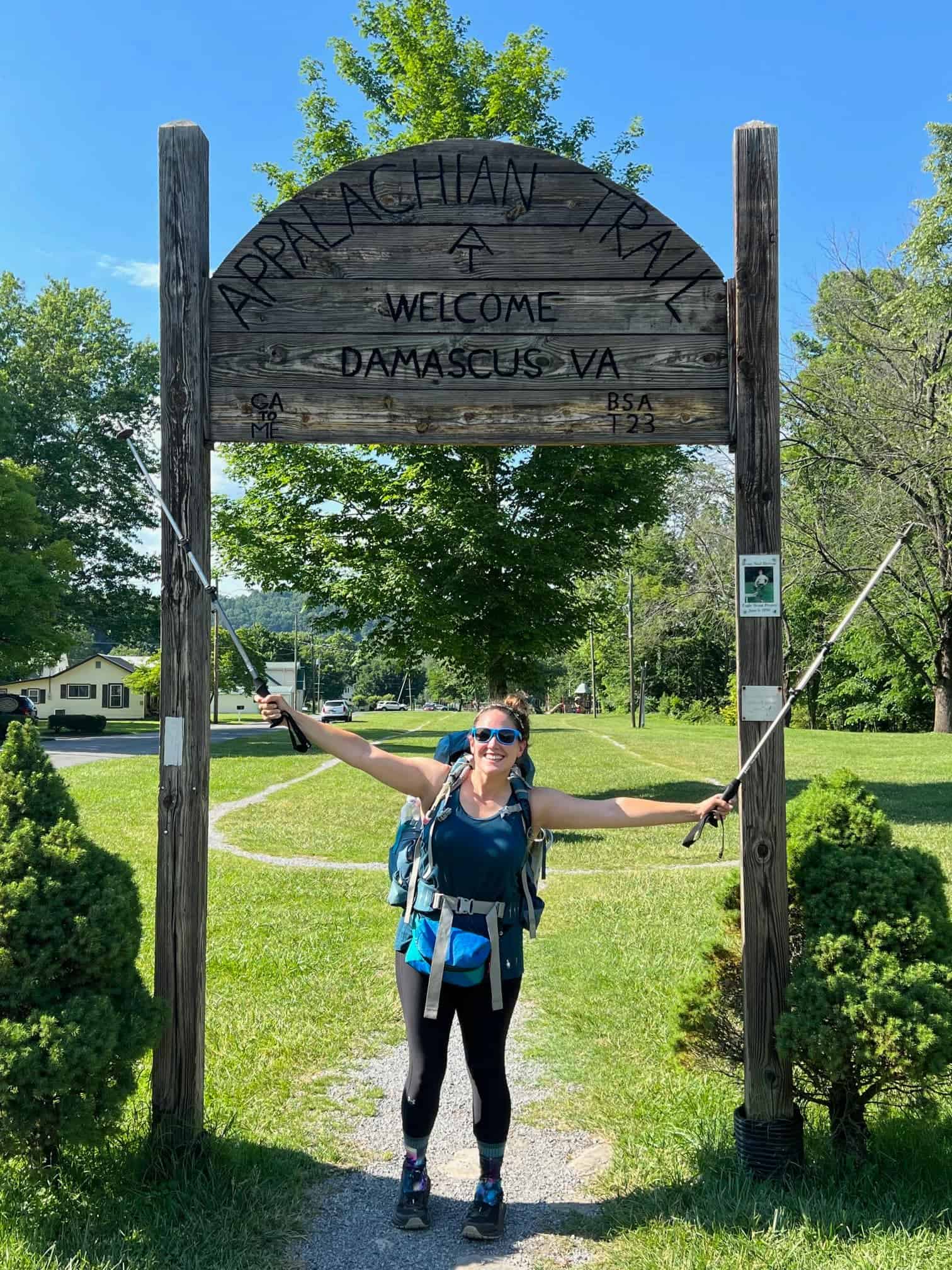
Husband’s Pick
Barrett slept in the same shirts he hiked in. He carried a second Outdoor Research Men’s Echo T-Shirt and a second Men’s Smartwool Merino Sport 150 Hoodie, one of each for hiking and sleeping.
Camp Pants
You’re looking for comfort and warmth from camp pants without adding much weight.
We have reached what I consider my most luxurious item, my Vuori joggers.
My Pick:
Vuori Performance Jogger Pants
(9 oz)
It’s the little things on trail.
If an item brought me daily happiness, it was tough to ditch. So I hiked the entire trail with these joggers.
Could I have slept in another pair of leggings? Sure. But these jogger pants only weigh 9 oz, so basically the same weight as another pair of leggings.
Did it feel luxurious every night to fall asleep in these soft-as-butter joggers? Yes!
It was lovely to let my legs breathe in the evenings and be free from legging compression, yet warm.
If this is also important to you, try them out!
Husband’s Pick:
REI Co-op Active Pursuits Shorts – Men’s 7″ Inseam
(7.9 oz)
Barrett originally purchased these REI Co-op Active Pursuits Shorts to hike in but realized he didn’t enjoy hiking in shorts with sewn-in crotch support.
They were, however, comfortable for sleeping in. And because of the crotch support, he didn’t have to wear the boxers he had just hiked in all day while sleeping in them.
He also used the zip-up pocket for easy-to-reach earplug storage.
Zero Day Outfit
Some hikers like to carry a dedicated “zero-day” outfit to wear around town while everything else is being washed.
It’s up to you; it’s not necessary. Hostels generally have “loaner clothes” you can wear while you wash your hiking clothes.
If you want to hike with a zero-day outfit, bring something lightweight that can also be hiked in, in case you need another option before your next zero-day.
I usually wore a Smartwool tank top that I also slept in when it was hot, and then my second pair of shorts or joggers that I slept in instead of having another outfit.
My husband had a bit more fun with it and carried an extra Hawaiian shirt to wear on zero days, along with his sleep shorts.
Rain Gear
The Appalachian Trail sees a lot of rainfall every year.
You can try to be crafty and avoid it. We did that for a while.
Eventually, we learned you must “embrace the suck” and hike in the rain to continue putting in the miles needed to get to the finish line.
When picking out the best rain gear for the Appalachian Trail, you want to consider what will be breathable (pit zips are helpful here), provide wind protection and keep you warm.
Rain Jacket
If it’s warm out and raining, you probably will simply be hiking in your hiking shirt.
Rain jackets come into play when you are getting wet in the cold. (They are also great for wind resistance when it’s too warm to hike in your puffy.)
Funny enough, rain jackets on the trail aren’t really for keeping you dry; they’re for keeping you warm and preventing hypothermia.
Something to keep in mind, hiking in rain jackets will lead almost all of them to “wet out.”
This is generally due to a combination of things. First, you are sweating because you are hiking in the jacket. Then, if the jacket becomes soaked from the rain and the DWR treatment fails, it will lose its breathability. Eventually, you have a jacket that has “wet out” and is wet on both the inside and outside.
With this in mind, I recommend looking for the lightest (and cheapest) option that will also keep you warm.
My Pick & Husband’s Pick:
Frogg Toggs Xtreme Lite Waterproof Rain Jacket & Frogg Toggs Ultra-Lite2 Poncho
(7.3 oz & 8.25 oz)
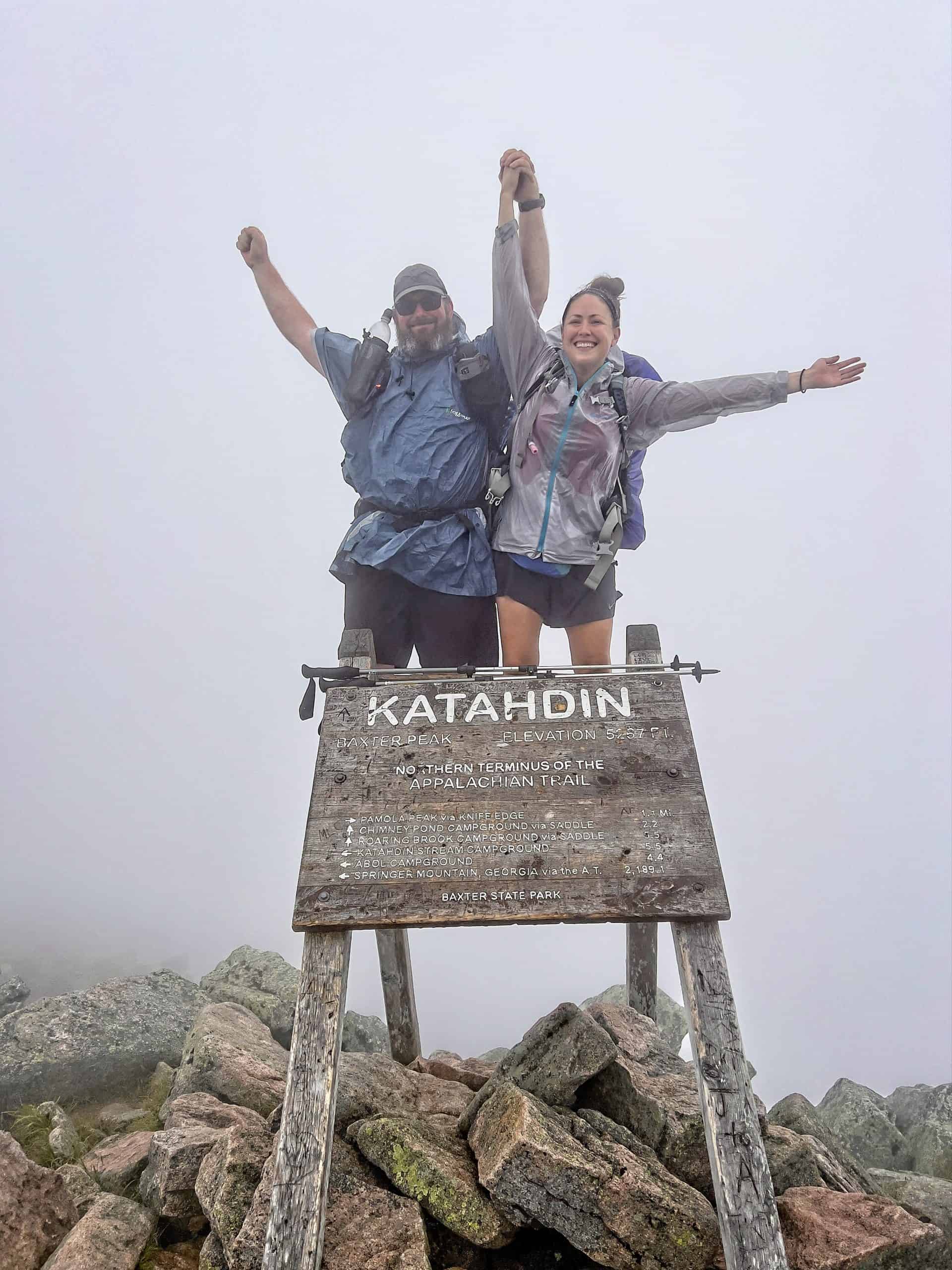
I picked up this Frogg Toggs Xtreme Lite Waterproof Rain Jacket pretty early on and hiked with it for the entirety of the trail.
- Made with Frogg Toggs breathable, waterproof, wind-resistant, and lightweight material
In the beginning, Barrett picked the Frogg Toggs Ultra-Lite2 Poncho for when it was warmer and he wanted protection from the rain. It had good airflow and could cover his pack.
- WATERPROOF – 100% waterproof, seam taped, lightweight and durable non woven Polypropylene material perfect for year after year use. PFAS free, no forever chemicals in materials or production
However, once he switched to his waterproof Hyperlite pack, he opted to be wet instead of wearing the poncho.
Marmot PreCip Eco Rain Jacket: Amazon | REI
Once it became cold again, he used this Marmot PreCip Eco Rain Jacket primarily for wind and rain protection.
(12.4 oz in XXL)
- Stay Comfortable and Dry - Designed for adventure even in rain, the Marmot Men's PreCip Eco Jacket is durable and designed with fully waterproof and breathable PFC-free DWR Marmot NanoPro nylon ripstop fabric with fully sealed seams – perfect rain jacket for men whether jogging, hiking, golfing, or just to add to your best backpacking gear
Rain Pants
If you naturally run cold like me, consider picking up a pair of rain pants to help keep you warm in the rain.
I snagged a pair of these Marmot Bantamweight Rain Pants on clearance; otherwise, I wouldn’t have spent the money. They sure were lovely, though!
My Pick:
Marmot Bantamweight Rain Pants
(2.9 oz)
Pro: They weighed almost nothing and kept me warm during cold rainstorms.
Con: They tore a bit too easily. Maine and New Hampshire ripped the shit out of them.
Rain Kilt
On the flip side of pants, kilts are worth looking into if you naturally run warmer.
They will keep your groin and quads area dry but are more breathable than pants.
Husband’s Pick:
ULA Rain Kilt
(3.5 oz)
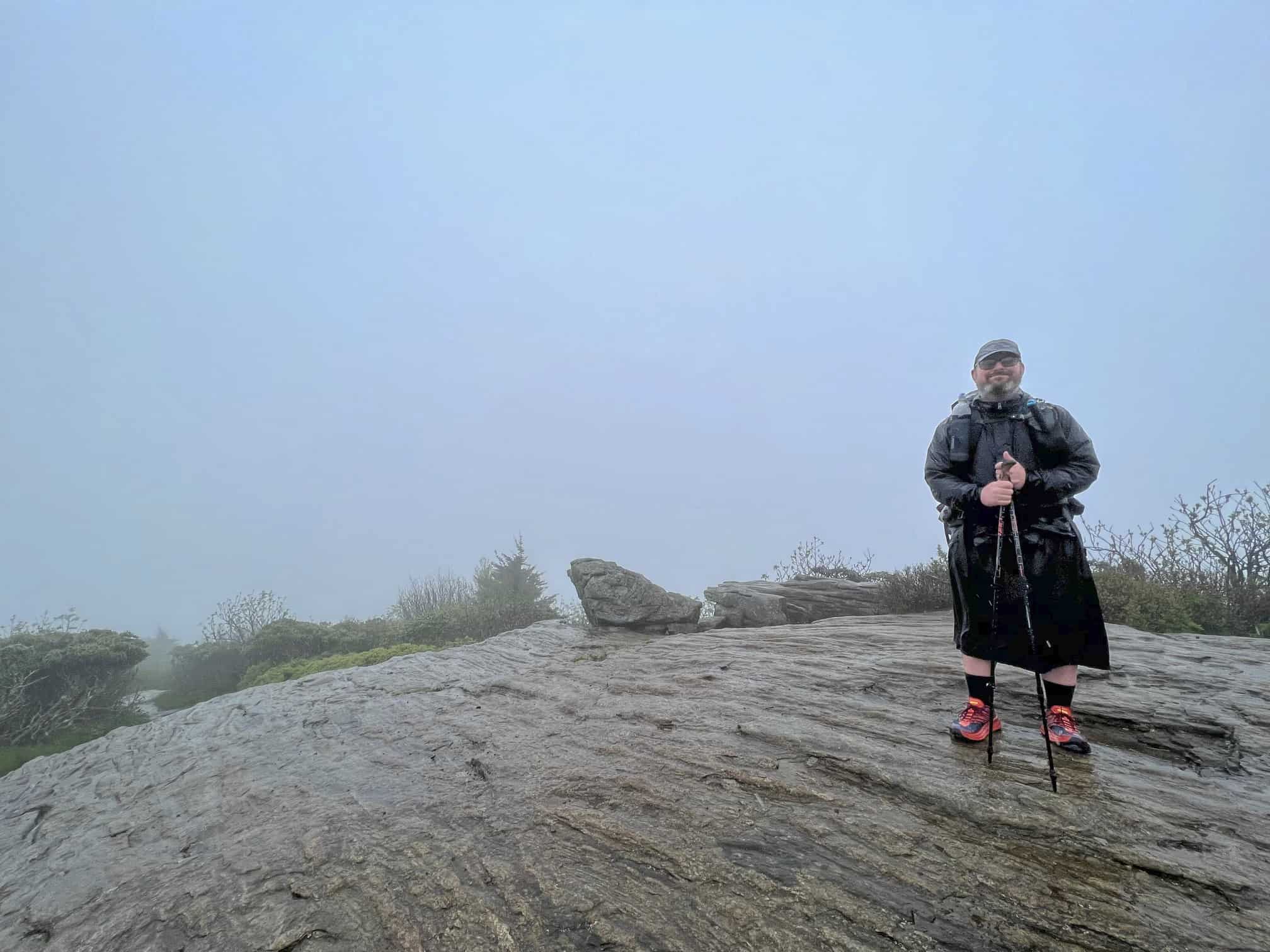
Barrett admitted he was skeptical about this lightweight rain kilt in the beginning.
But he enjoyed it once he realized it would keep his quads and groin somewhat dry and warmer in the rain while providing airflow on his legs, so he didn’t overheat.
Sunglasses
Despite being known as the “green tunnel,” you will see the sun sometimes on the AT.
I wouldn’t hike with anything too fancy in the sunglasses department. (Or really in any of the wearable item departments.)
Sadly, it would be best to accept that sunglasses will likely become scratched or broken unless you carry them in some form of protective case.
These Crystal Light containers are a popular choice for those trying to protect a pair of shades:
Gloves & Glove Liners
Gloves and glove liners help you reduce the amount of heat lost through your fingers on frigid hiking days, helping you stay warm and enabling your fingers to maintain their dexterity while hiking.
When seeking out gloves for thru-hiking, keep their warmth-to-dexterity ratio in mind.
Thin softshell gloves will give you more dexterity but less protection from the elements. Thicker pairs will provide more protective lining, but you will lose finger flexibility in exchange.
They will also generally not be fully waterproof, so they’re yet another gear item you’ll want to be made from wool or synthetic materials since those will retain warmth best while wet.
A set of water-resistant synthetic gloves made from fleece or neoprene, paired with merino wool glove liners, will be the best combo for saving your hands from the wind and cold, with some added rain protection.
You’ll want to layer the mitts mentioned next over them for maximum rain protection.
I went with the Midweight Sensor Gloves from Outdoor Research.
My Pick:
- Fabric Performance: Breathable, Lightweight, Wicking, Quick Drying, Thermo-regulating ActiveTemp treatment
My hands were still a bit too wet or chilly in these gloves a few times.
These Minus33 Merino Wool Glove Liners would be a great liner choice to use with these gloves if you get cold easily.
- QUALITY MERINO WOOL GLOVE LINERS: 85% Merino Wool. Warm and comfortable. Machine washable and dryable. Add these merino wool glove liners underneath your favorite work or outdoor gloves and feel the difference. Sizes S - XL 85% merino wool for superior warmth. 10% Stretch Nylon and 5% Elastic gives better durability and comfortable fit. Use by themselves on mild days or combine them with your favorite gloves for your next cold weather adventure.
Husband’s Pick:
Barrett felt an appropriate warmth-to-dexterity ratio in these Black Diamond Lightweight Softshell Gloves.
- Four-way stretch softshell fabric with DWR treatment
Rain Mitts
Rain mitts provide the final piece of the ultimate handcare puzzle.
They’re the waterproof shell worn over your gloves and glove liners that will keep your hands dry when it’s raining.
They’ll also provide you with the maximum opportunity for warmth when it’s windy and/or cold.
Wet & Dry Grip Gloves
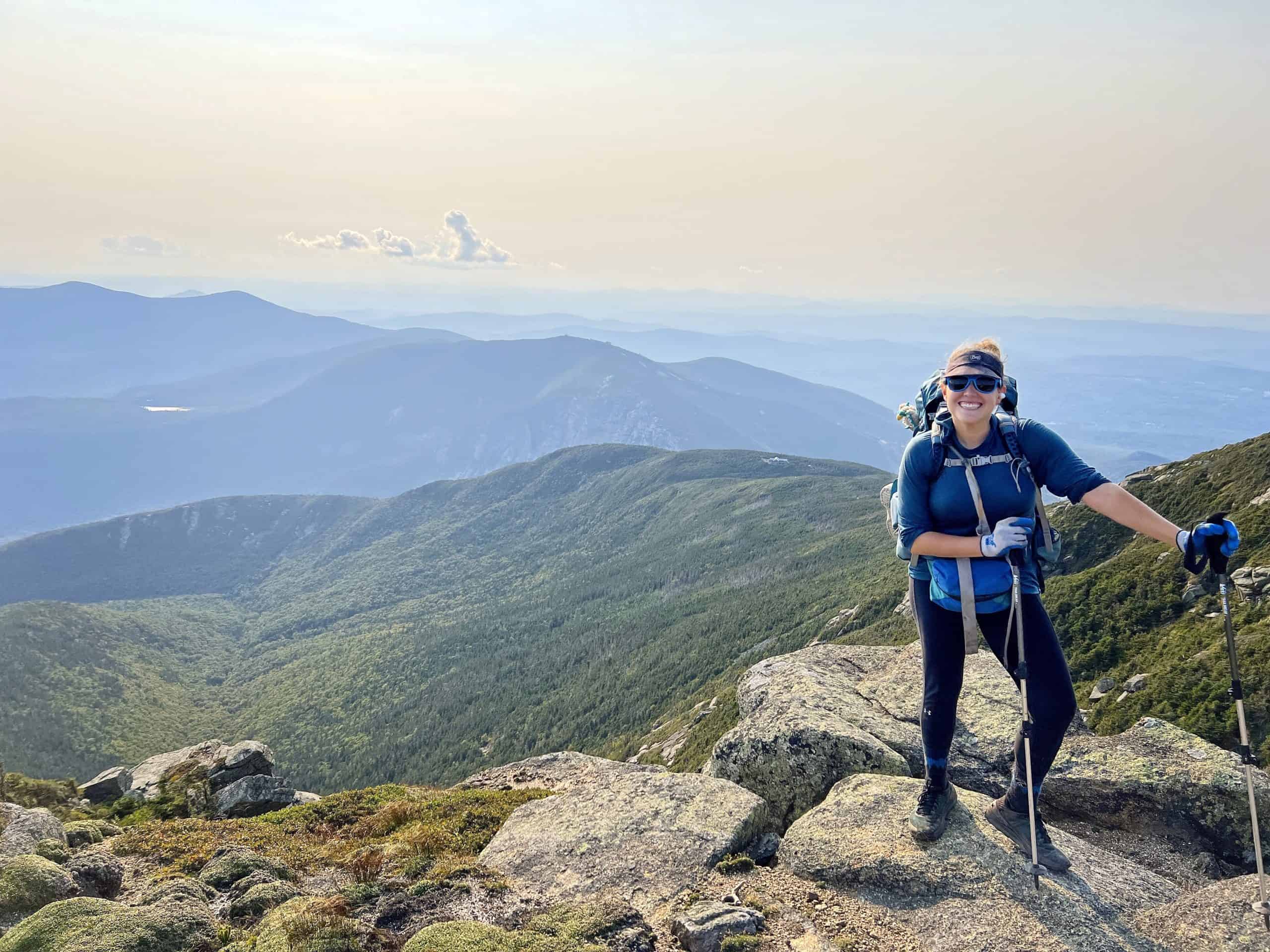
Wet & dry work gloves are helpful for a small section of trail in New Hampshire and Maine that is particularly brutal on the body. For NOBOs, it’s the miles approximately between 1800-2020.
I sent my trail friend Tortoise these pictures of my hands and knees after going through Mahousic Notch (Since we’re Flip Floppers, we were SOBO by this point.)
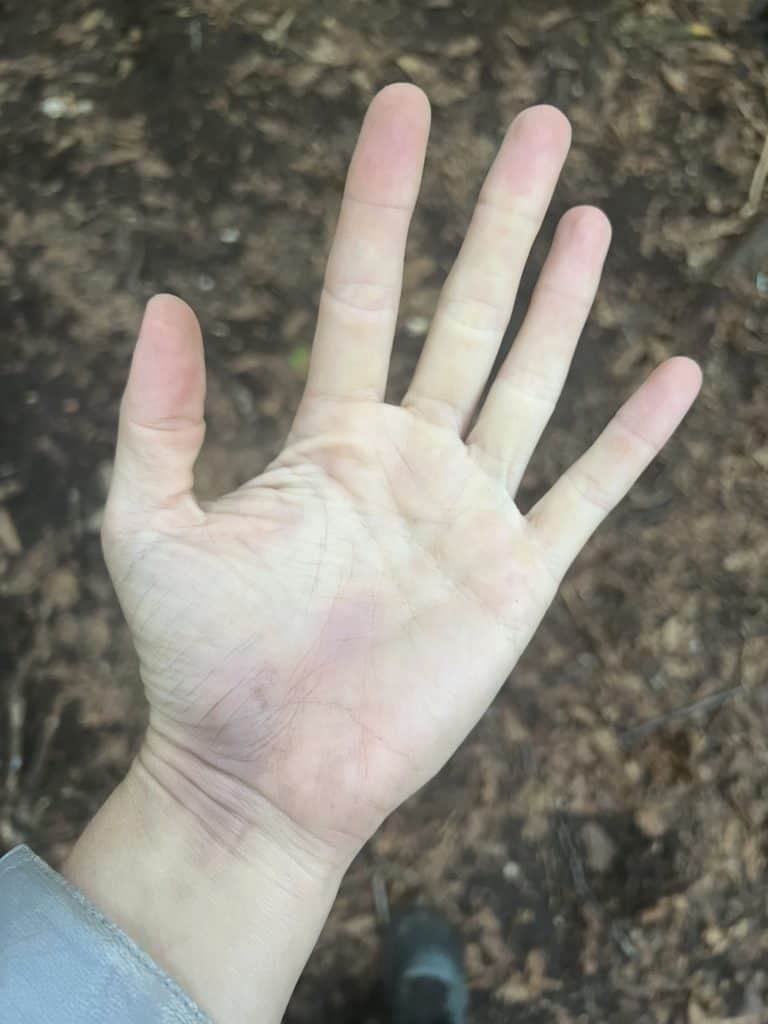
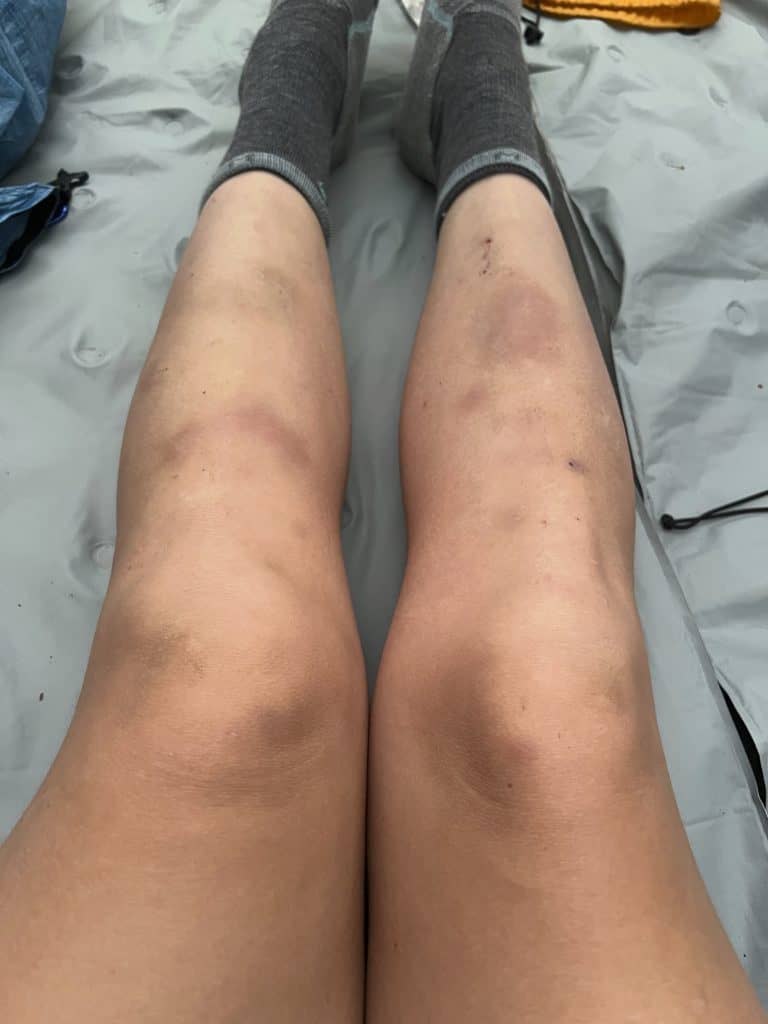
We happened to zero in Gorham around the same day, and I returned from a resupply to these bad boys on my door knob:
- Seamless poly/cotton lining
Holy hell, did these things help! Suddenly, I was scaling rock walls pain-free and with the grip of Spiderman.
For that 220-ish mile stretch, if you bruise easily or would like some extra grip, I recommend picking up a pair of these at a hardware store along the trail.
You want a pair with both grip and hand protection qualities for this section.
Hats & Other Headwear

Hat
Hats with a brim protect your head from the sun while also keeping the rain and sun out of your eyes.
The lightweight Swift Cap is favored along the trail due to its sweat-wicking abilities, side heat venting, and UPF 50+ sun protection.
Outdoor Research Swift Cap: Amazon | REI | Backcountry
(2.5 oz)
- Fabric Performance: Water-Resistant, Breathable, Lightweight, Wicking, Quick-Drying, TransAction Headband, Mesh-Lined Crown, UPF 50+
My husband most enjoyed wearing this hat when it was hot outside and at the beginning and end of the hike when the leaves had fallen off the trees, exposing us to much more consistent sunlight.
When it was cold, he would wrap his Buff around it to keep everything in place and have protection from the chilly conditions.
Visor
Visors are great for keeping the rain and sun out of your eyes while also providing some breathability for the top of your head and a hole for a ponytail to go through.
I started in a running cap but quickly realized I didn’t like the limited eyesight and ponytail options provided with a hat.
Enter the Buff Pack Run Visor – a lightweight, cooling, wicking, odor-controlled visor.
I loved this thing and wore it almost every day!
(Also, if I felt too warm in it, the brim flipped up for temporary relief.)
Buff Pack Run Visor: Amazon | Backcountry
- Ultra 4-Way Stretch Fabric- Optimum fit that stretches in all directions.
Headband
Headbands are super helpful, especially on hot, muggy days when you want to keep all your hair in place and out of your eye line.
You also can dip them in a stream to get instant relief from the heat.
This Buff tapered headband has cooling technology built into it, odor control, can be worn many ways, and has little silicone grippies that ensure it stays in place.
That was a big deal for me because headbands tend to slide right off my head.
BUFF Headband: Amazon | Backcountry
- MULTI-FUNCTIONAL: Flip around for a different look, tiny silicone drops keep band in place and hair out of face, made of 95% recycled polyester, 9.5 cm wide, one size fits most adults
Buff
Buffs are an ultra-versatile way to get UPF 50+ sun protection. They also can be worn in 12 different ways, have odor control, dry fast, and are easy to clean.
Buff CoolNet UV Neck Gaiter: Amazon | REI | Backcountry
This gaiter is specifically great for both hot and cold days:
- MULTI-FUNCTIONAL: Wear 12 different ways, made of 95% recycled polyester, one size fits most adults
In the cold, my husband used it to block the wind, lock his hat in, and add warmth to his neck and ears without overheating because sometimes his beanie was too hot to wear while hiking.
In the heat, it kept the sweat out of his eyes and could be dipped into the water and then worn for some cooling relief.
On full moon nights, it was even his sleep mask.
My husband grew very attached to his, eventually lovingly referring to him as either Sir Buffington or Buffy Boy.
Sun Hat
Sun hats with wrap-around neck protection can be great for those who burn easily, protecting more unprotected areas from the sun.
They’re also excellent to wear in conjunction with bug nets, so your face has some room to breathe.
Barrett started the trail with a sun hat but quickly felt we never saw enough sun to make carrying it worth it.
It was too big, with too much material. He switched to the swift cap up above for most of the hike.
Beanie
Beanies are excellent for retaining warmth while hiking in cold temperatures. They’re also wonderful on frigid evenings, especially for those sleeping in quilts who lack the mummy bag wrap-around-the-head feature.
Specifically, a merino wool beanie is recommended for its temperature regulation, odor resistance, UV protection, quick-drying capabilities, and durability.
We each started with one. This one from Minus33 is great because it has two merino wool layers yet is still very slim and lightweight.
And then, once we were in hunting season, we got orange ones. (More on hunting season below.)
(2.4 oz)
- QUALITY LIGHTWEIGHT PACKABLE BEANIE: 100% Merino Wool is super soft and extremely comfortable. The best in easy care technology means your merino wool is machine washable and dryable. Comfort, warmth, and breathability make this hat an essential part of your outdoor gear. One-Size fits most. Double fabric for warmth. Simple yet stylish.
Once we got the orange beanies, I discovered the warmth of the double beanie and hiked the rest of the trail in two beanies!
👉 Click Here to Get My Free Appalachian Trail Gear Packing List for Thru-Hikers
Continue Reading:
– SHELTER
– SLEEP SYSTEM
– BACKPACK
– CLOTHING
– FOOTWEAR
– FOOD, COOKING GEAR, & WATER TREATMENT SYSTEM
– SAFETY & REPAIR ITEMS
– ELECTRONICS, NAVIGATION & GPS, HYGIENE ITEMS, & BUG MANAGEMENT
– PERSONAL LUXURY ITEMS & FAQS
- Hiking the Appalachian Trail: Week 3 Thru-Hike Journal - March 27, 2025
- Best Appalachian Trail Shoes for Long-Distance Hiking - March 4, 2025
- Backpacking Clothes for an Appalachian Trail Thru-Hike - March 4, 2025

